Making Bread Machine Dough and Baking It in the Oven: A Tutorial
Sneak Peek: If you’ve been curious about bread machine dough and baking it in the oven, this post will tell you how to do it and why it’s a good idea.
Click here if you are looking for the Oatmeal Sunflower Seed Bread Recipe that used to be part of this post.
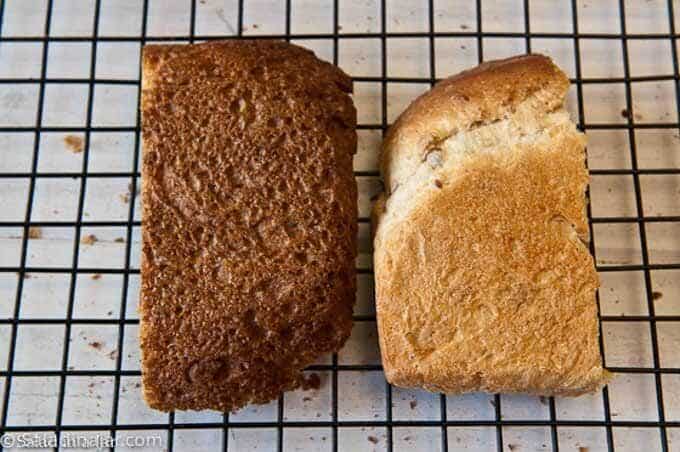
As an Amazon Associate, I earn from qualifying purchases.
The “automatic-ness” of a bread machine can mess up a loaf when you try to bake it in a bread machine. Maybe we’ve all expected too much. After all, a bread machine operates on a timer, not a brain. My solution is to make bread using only the DOUGH cycle.
Four Reasons Why You Will Fall in Love with the DOUGH Cycle on Your Bread Maker
1. Your Bread Machine is One FABULOUS kneading machine.
Stick with the DOUGH cycle, and use your bread machine for what it does best–kneading dough. In my opinion, it’s better than a stand mixer, especially for beginners who can’t always judge when the bread has been kneaded enough.
2. You Control the Timing.
When the DOUGH cycle finishes, you will proceed based on the environment in your kitchen, the ingredients in the recipe, the appearance of the dough, and your personal schedule.
3. Shaping by Hand Creates Beautiful Bread
When you shape bread machine dough by hand, the bread has a neat, uniform texture–not crumbly. The tension created by shaping makes a thinner crust and a more appetizing appearance.
4. Avoid a Crust That is Too Dark, Tough, and Too Thick
Check out the first picture at the top of this post. Use the DOUGH cycle if you prefer the crust on the right instead of the left. Among other things, bread makers don’t get as hot as your oven, which results in a thick, tough, and tasteless crust.
Please don’t be intimidated by the idea of getting more involved in the process. Try it, and you’ll see.
Even beginning bakers can do better than a bread machine left to its own devices.
Happy Bakers Speak Up
“When I researched, using a long question about dough cycles and oven baking, I did not expect any joy! However, there you were and I got what I needed and more. Thank you for your time as I now understand about shaping and 2nd rise but also have your tip about using the microwave to assist said 2nd rise.“–LYNN
Making Bread Machine Dough with the DOUGH Cycle
These are general instructions for making the dough for any bread machine recipe on the DOUGH cycle. When you use one of my bread machine recipes, I will give you specific details so you won’t have to guess.
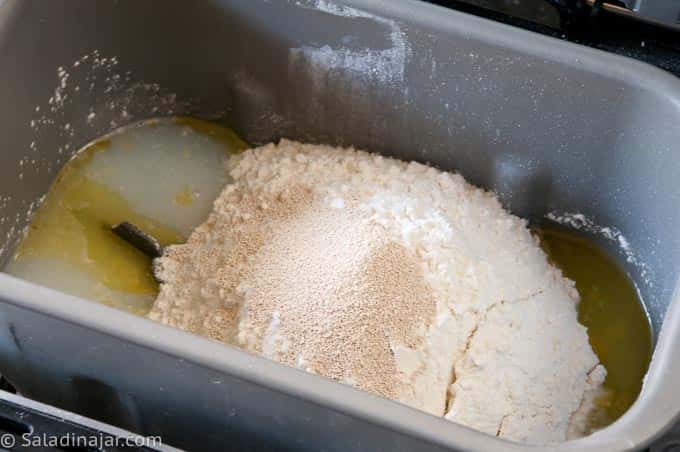
Note: Bread machine yeast (aka instant yeast) was designed for bread machines–no dissolving in liquid is required. Dump it in all the other ingredients. However, you can use active dry yeast, but it is more trouble and can be slower to rise.
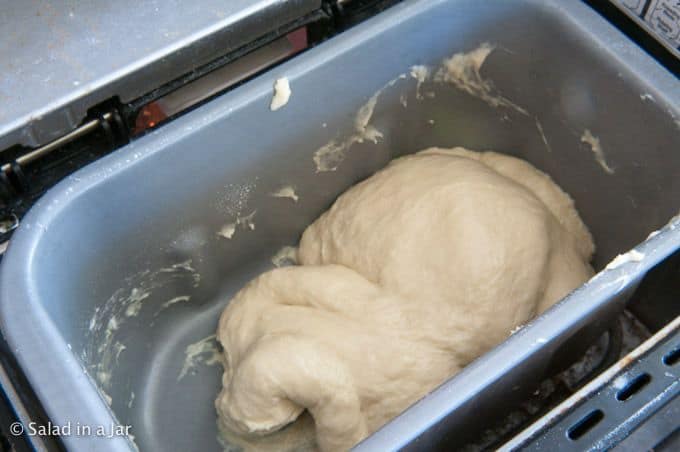
For further instructions, see this post about the most important thing you should do when making bread in a bread machine.
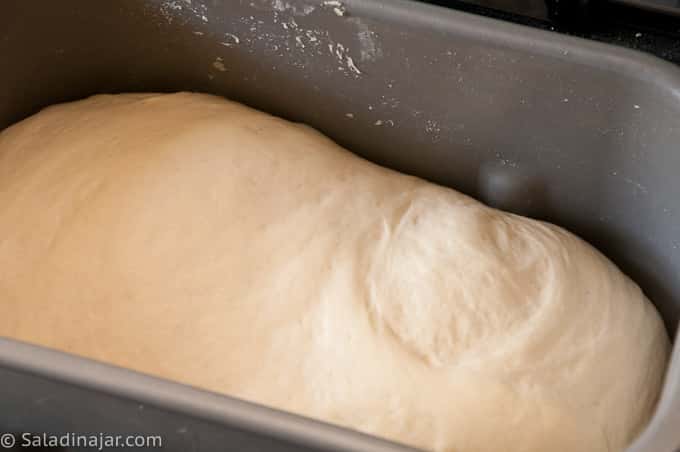
This is the proofing stage. The manual with your bread machine may say there are two rising times. Those two equal the first rise you normally allow when making bread by hand or with a mixer.
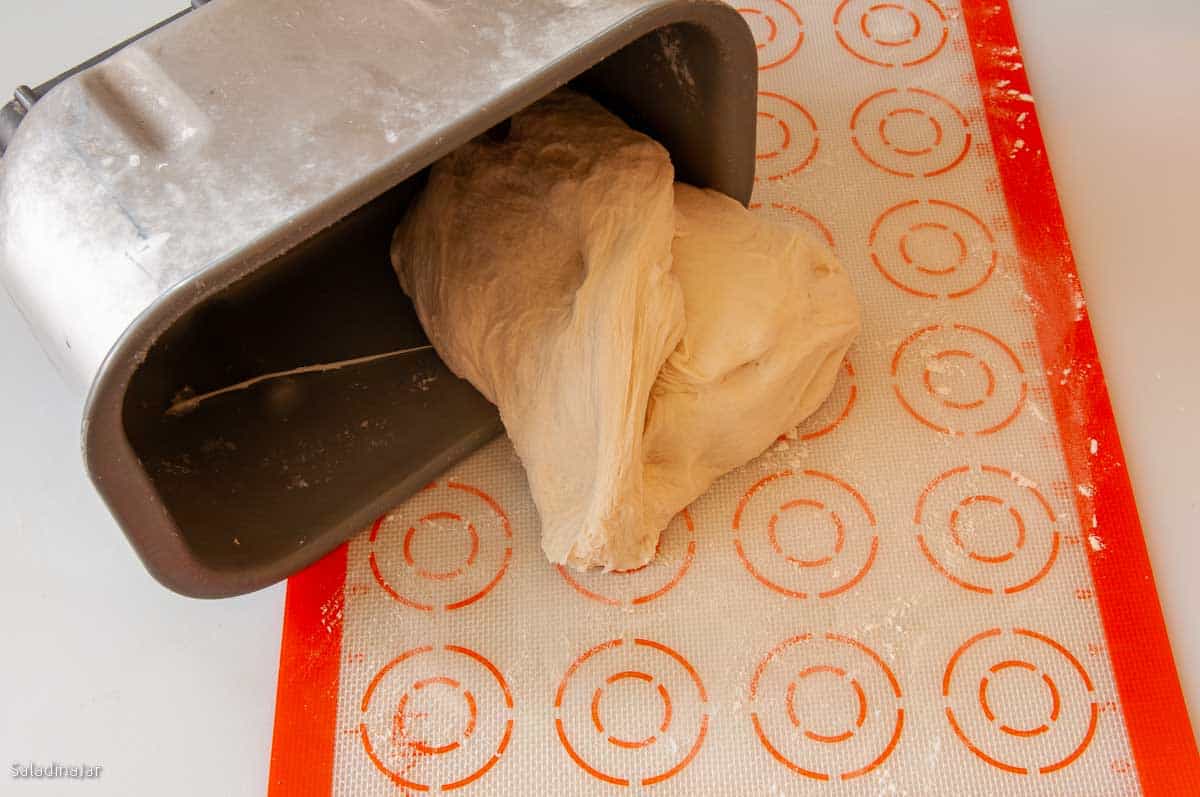
How To Shape Bread Machine DOUGH into a Loaf You Can Bake in the Oven
At this point, you can shape the dough however you wish. The following picture shows how to make a standard loaf. If you want to shape your bread into a free-form like French bread, see this post.
Begin rolling the dough into a cylinder, starting with the short side closest to you. Take care that no excess flour remains to cause tunnels in your bread. Pinch the seams together. Tuck the ends toward the seam and pinch.
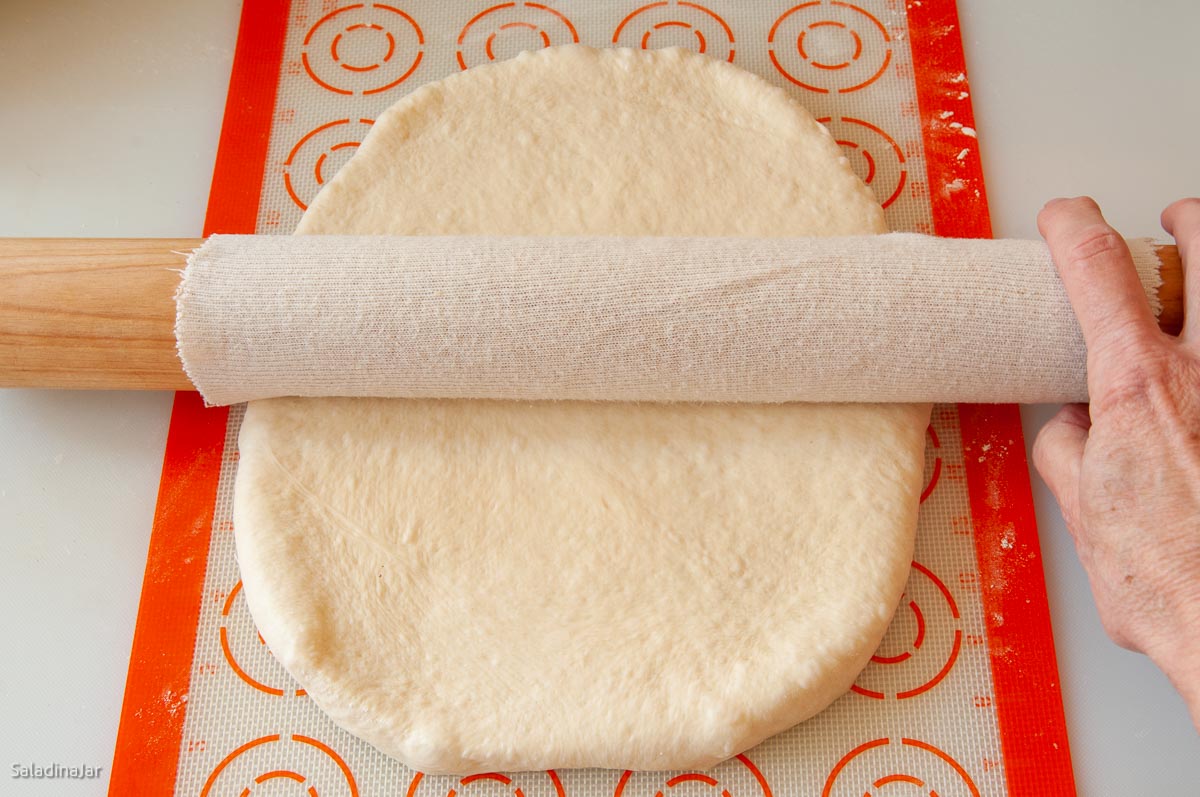
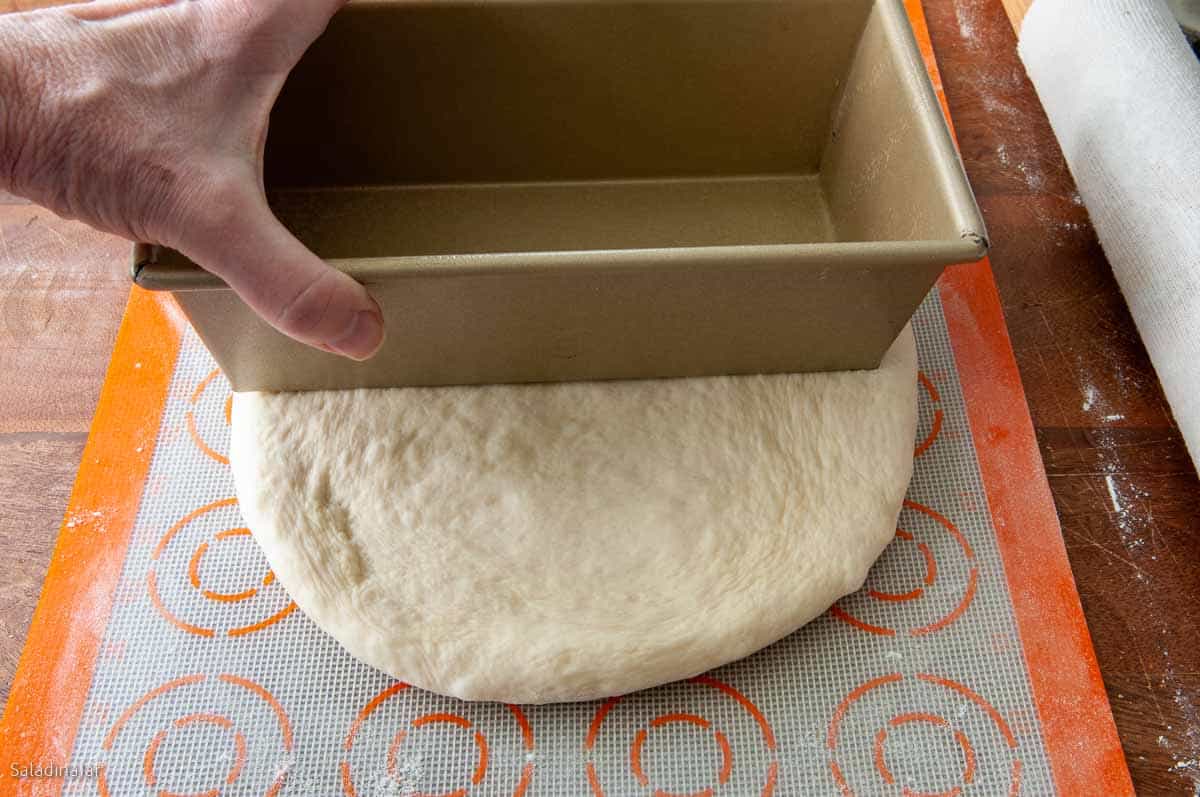
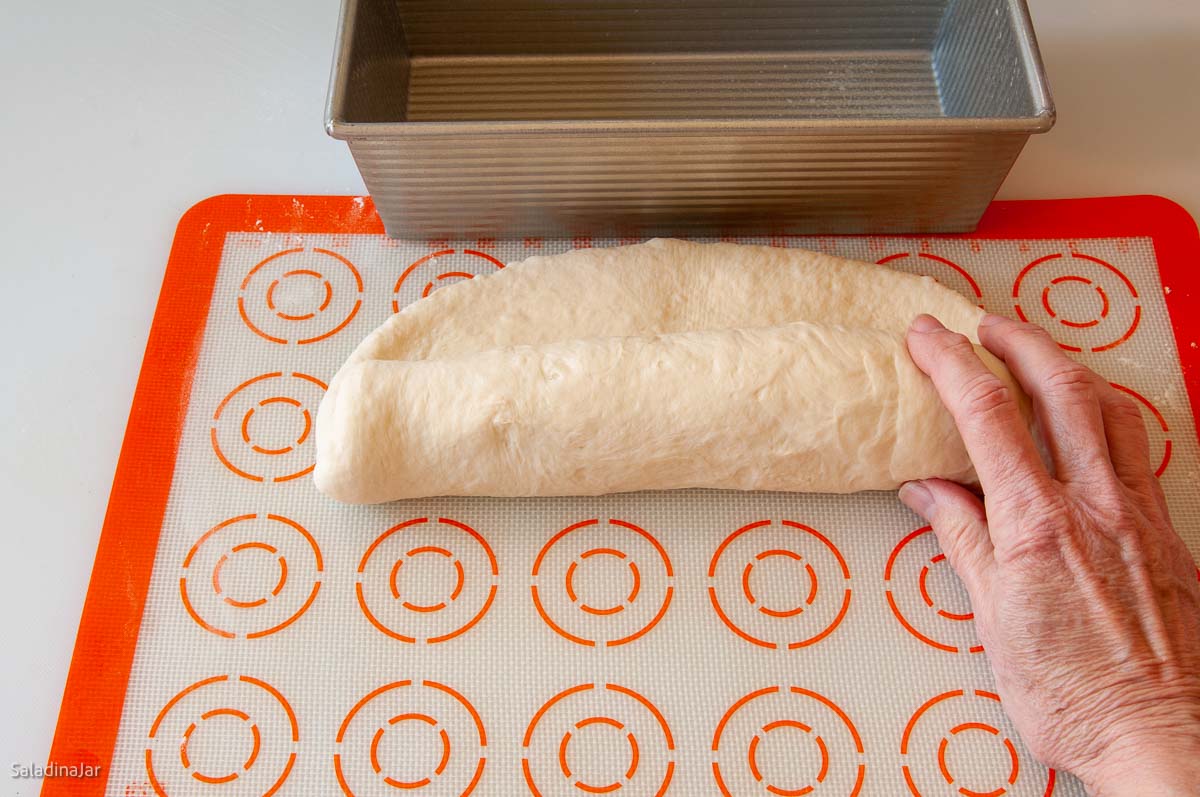
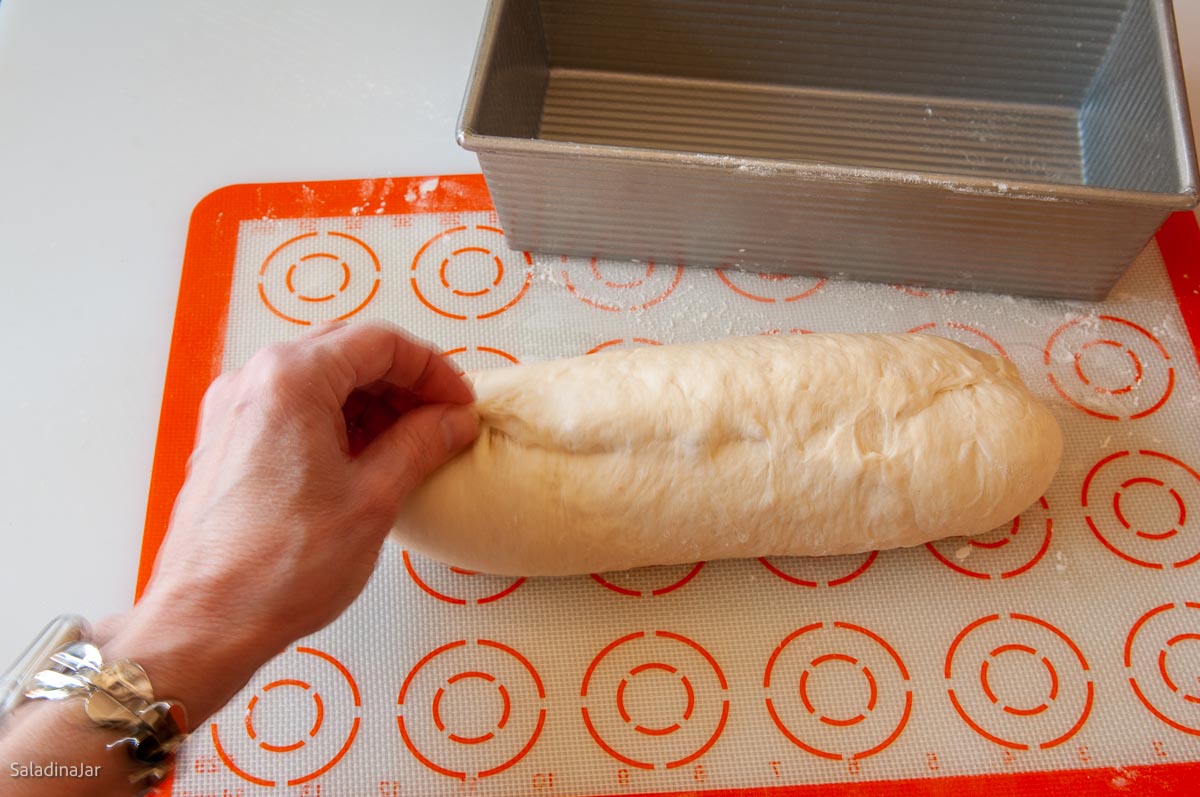
What Size Pan Should I Use?
Deciding the size of the loaf pan you will need is crucial to the appearance of your baked loaf.
Too small, and your bread will rise out of the pan. Too large, and your bread will appear squatty or like it wasn’t allowed to proof long enough.
📌Kitchen Tip📌 After shaping the dough as shown above, lay it into the loaf pan you plan to use. Your bread dough should roughly fill the loaf pan half full. If it fills more than 1/2 of the pan, the pan is probably too small. If it is significantly less than half full, try a smaller pan.
Exceptions to the Pan-half-full Rule
- If your recipe contains a lot of seeds, whole grains, or whole-grain flour, it won’t rise as high. Instead, use a slightly smaller pan, like an 8½ x 4½-inch bread pan.
- Try a larger pan if it’s a high-rising, light, and fluffy loaf such as this Sweetened Condensed Milk Loaf or the Honey Whole Wheat Bread.
For a 1½-pound loaf with 3-3½ cups of flour (360 grams), my favorite size is 9 x 5 inches when measured on the bottom. (It will hold 8 cups of water if you want to compare it with a pan you already have.) I also have an 8.5 x 4.5 loaf pan that I use for 3-cup-of-flour recipes that don’t rise as high.
When using the recipes on this website, I tell you what size is best in my experience. If you don’t have that size, you can improvise.
How To Improvise
If the only pans you have are too small, cut the dough into portions and make rolls, a free-form loaf, or a second mini-loaf with the extra dough.
Still not sure what pan you should use?
Try a 9x4x4-inch Pullman pan (paid link) with tall sides. It will hold a high-rising loaf or a low-riser and look good because the sides are straight up, not angled out. Many people use this pan for sandwich bread because it makes a square-shaped slice of bread.
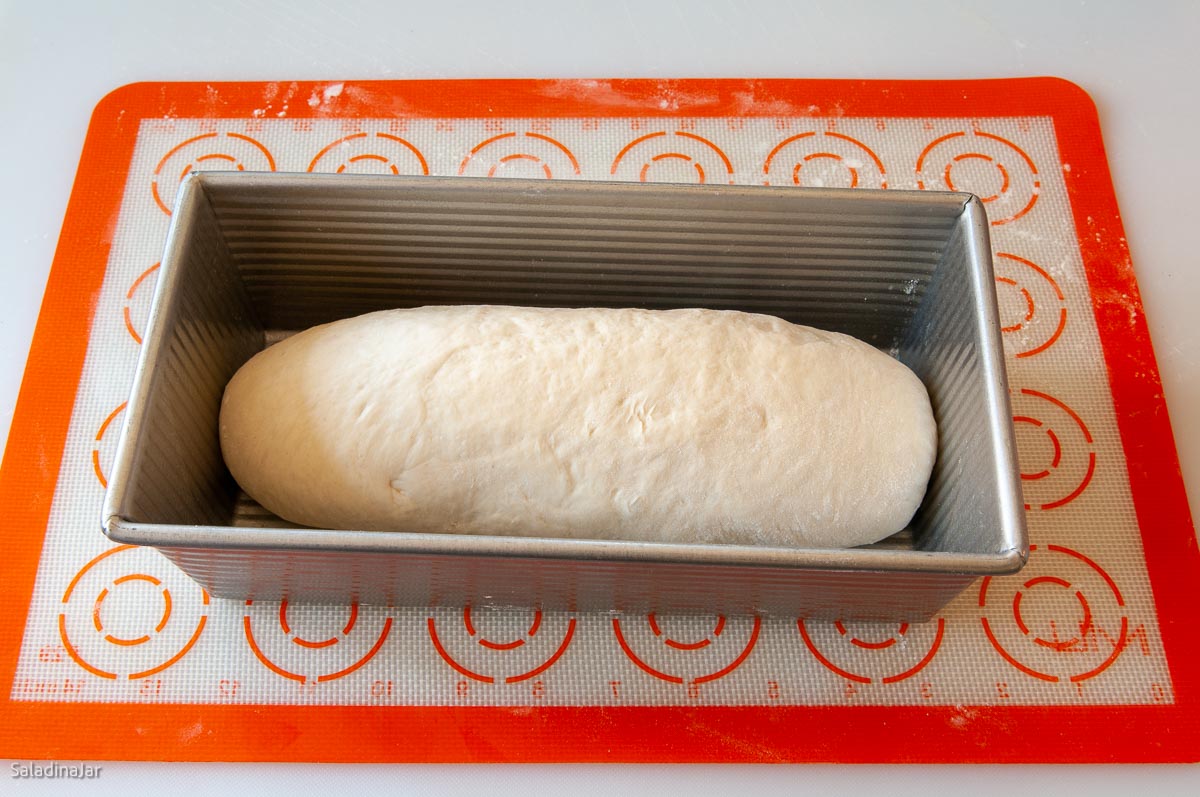
Proofing the Dough After It Has Been Shaped
1. The Final Rise is Crucial
Please don’t leave it out. It determines the final size and texture and develops the best flavor from the yeast.
To clarify: The first rise happened inside the bread machine on the DOUGH cycle after the kneading phase. (Your machine may say there are two rises during the DOUGH cycle. Those two rises equal one rise you would allow when making the bread by hand.)
When you pull the dough out of the machine after the DOUGH cycle ends, you take control of the rest of the process. You will shape the loaf and let it rise again before baking.
2. How Do I Set Up My Bread for the Final Rising Time?
First, shape the dough into whatever shape you want. See the instructions above. Then, cover the loaf with a tea towel or a cheap shower cap.
Place the loaf pan or rolls in a warm place to rise. My favorite way to create a cozy environment is to boil a cup of water in a microwave for 2-3 minutes. Place a small silicone spatula in the cup to avoid superheating. Leave the hot water in the oven and place the covered dough next to it inside a closed microwave.
DO NOT TURN ON THE MICROWAVE WITH THE DOUGH INSIDE.
3. How Long Should My Bread Dough Rise After I Shape It?
For most recipes, the dough should almost double in volume. Thirty minutes may be all you need for classic dinner rolls. If the room is chilly, it could take 45-60 minutes. If the room is very warm or humid, it could take much less time.
Loaves usually take longer to rise than rolls. Forty-five minutes is a good place to start for a loaf, whether in a pan or freeform.
Ambient temperature, humidity, and the ingredients are variable factors that will affect how fast bread dough rises. When you control the timing of the rise yourself, you can get it right every time.
Caution: Don’t go by the clock! Go by careful observation of the dough as described below.
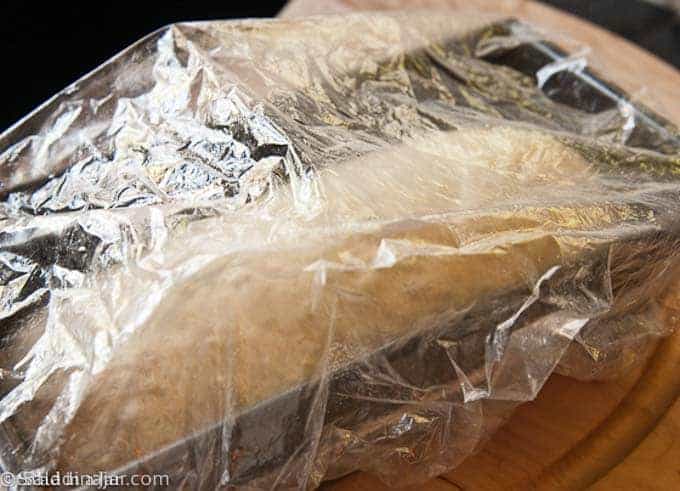
4. How Can I Tell If the Dough Has Risen Enough in the Pan?
The dough should peek over the edge or rise to no more than one inch above the top of the pan. If it rises too much, the yeast exhausts itself. As a result, your loaf may fall or have a big hole in the middle.
Unfortunately, you may not realize your error until you slice the baked loaf.
If the dough doesn’t rise enough, your bread will be compact and smaller than it should be. Use a finger to gently press on the side of the bread. It should leave a dent that slowly springs back–but not entirely.
5. What If My Dough Already Rose Too High on the Final Rise?
If you know your loaf has risen too much (maybe you forgot), dump the dough out of the pan onto a floured surface. Push it down, knead it several times, and reshape it. Let the dough rise again, but this time, watch closely. Read more about overproofed dough.
There are no guarantees this will work, but it’s better than baking a loaf that produces an overly yeasty and bland flavor, a poor texture, or collapses in the middle.
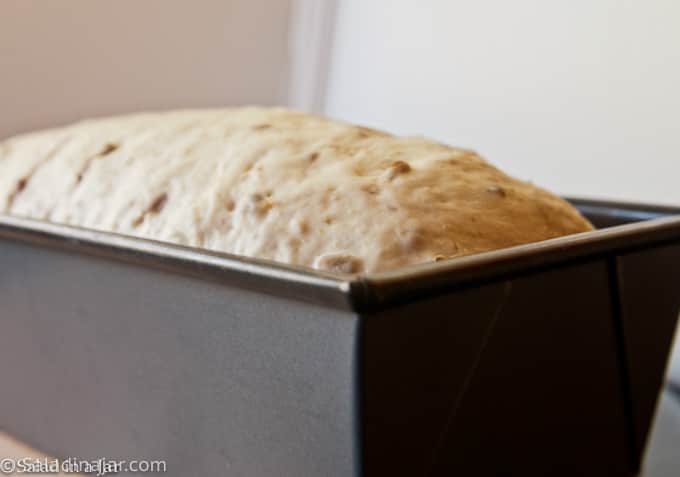
Baking Bread Machine Dough in the Oven
Use a preheated oven to get the best rise and the most excellent crust. It’s best to turn on the oven 15-20 minutes before you think your bread will be ready to bake.
Three Ways To Determine What the Oven Temperature and Cooking Time Should Be?
- Beginners may find it helpful to compare their bread machine recipes with similar recipes not designed for a bread maker. Look at how long they bake and at what temperature to point you in the right direction.
- A lean, rustic, or open-textured loaf like a ciabatta, French bread, or a simple sourdough will do better in a hotter oven in the range of 400-450˚F. The higher temperature works best when the recipe is simply water, flour, salt, and perhaps a very small amount of fat and sugar.
- Enriched bread, like this Hawaiian bread, should be baked at a lower temperature, 350-375˚F. Enriched bread contains milk, eggs, sugar, juices, or other ingredients that produce a softer, tighter crumb.
TIP: After making more sourdough loaves than I can count, I’ve learned that bread bakes better if you preheat the oven to 50˚F hotter than you want to bake your bread. Then, turn the oven temperature back to the specified number as you put your bread into the oven to bake. Every oven is different, but this is something to play with.
What if My Bread Gets Too Dark on Top But Isn’t Yet Baked in the Middle?
Some loaves may take longer or need to be covered halfway through baking. If necessary, aluminum f
All these details will require your attention the first time you try it, but you’ll figure it out once you make a recipe two or three times.
Why Beginning Bread Bakers Need a Thermometer
If you are a beginning bread-baker, I can’t stress how helpful it is to buy a quick-read thermometer with a probe:(paid link) The old-fashioned technique of thumping the bottom of a loaf to evaluate doness is about as helpful as thumping a watermelon if you haven’t done it all your life.
- For a basic flour-salt-and-yeast loaf, the internal temperature should be 200-210˚F.
- Enriched bread should reach an internal temperature of 190-195˚F.
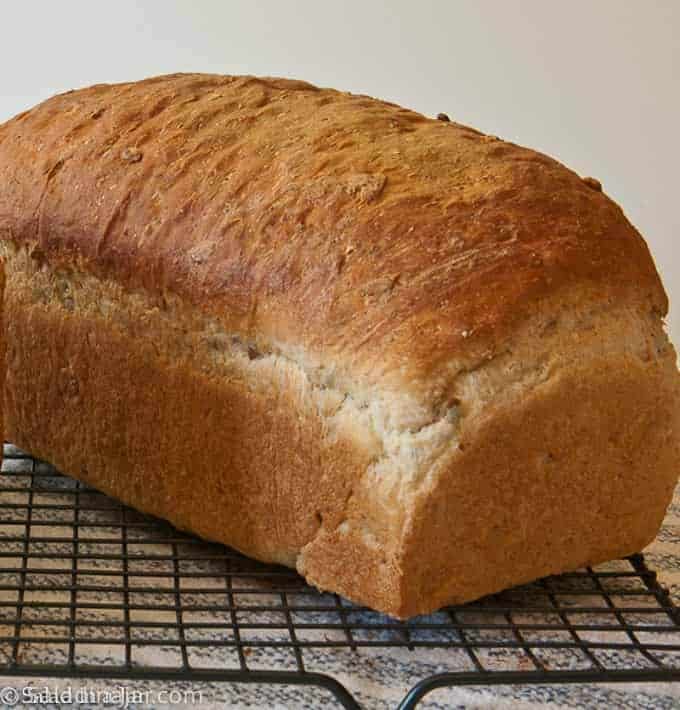
After the Bread Comes Out of the Oven
How Do I Cool the Bread?
- Leave your hot loaf in the pan to cool for about 15 minutes. Failure to do this may cause the sides to cave in, especially with a light-textured loaf.
- Then, use a thin knife (I use a plastic knife, so I won’t scratch the pan) to ensure the bread is not sticking. Turn the loaf out onto a cooling rack.
How Soon Can I Cut a Loaf of Home-Baked Bread?
- The answer to this question depends on the loaf. Most loaves need at least 30 minutes to an hour to cool. Some heavy loaves containing whole grains may need 2-3 hours.
- If you cut into them too early, you risk squashing them. Since they are still baking for a little while after you remove them from the oven, they can be gummy or crumbly when cut prematurely.
- Rolls cool much faster. Also, you don’t usually slice them. However, they can still be gummy and squishy if you don’t wait at least 5-10 minutes.
How Do I Store Homemade Bread?
- Remember that most homemade bread has no preservatives like store-bought bread. It’s usually better the day you bake it. Bread made with Tangzhong or potatoes stays fresh longer. Check out these recipes: Tangzhong Cinnamon Rolls: An Amazing Bread Machine Recipe, Best Japanese Milk Bread Dinner Rolls with Tangzhong and a Bread Machine, Multigrain Bun Recipe: Save Your Energy, Use a Bread Machine.
- Whatever you don’t eat immediately, store in a plastic bag or a bread box, although bread boxes vary in functionality. Some reportedly work better than others.
- I don’t recommend storing baked homemade bread in the refrigerator. It’s too humid.
- To freeze bread, slice it first, then double-wrap it. It’s best to use it within a month.
Parting thoughts: If you are looking for a better recipe than what you can find in the bread machine manual, can I suggest starting with this Bread Machine French Bread? Then try this basic white bread loaf that my readers love. Bread Machine Pizza Dough is also super easy for beginners.
Remember I said a bread machine has no brain! That’s why it needs your active participation to make fabulous bread you’ll be excited to eat and share. If you’re only looking for toast in the morning, I get it. But if you want bread worth the calories, time, and expense, stick with me. You’ll be making perfect bread in no time.
Happy Bakers Speak Up
“I was ready to throw my new machine out; the crust was hard or tough, and tasted like cardboard. Heavy and coarse. My husband kept saying it’s good, but I knew differently. I am fussy and definitely not used to eating bread like that. This morning I made it your way, kneaded in machine, baked in oven and it is bread to die for. Bread at its best.”–MARILYN D.
If you have questions or suggestions, email me privately for a quick answer: Paula at saladinajar.com. Hope to see you again soon!

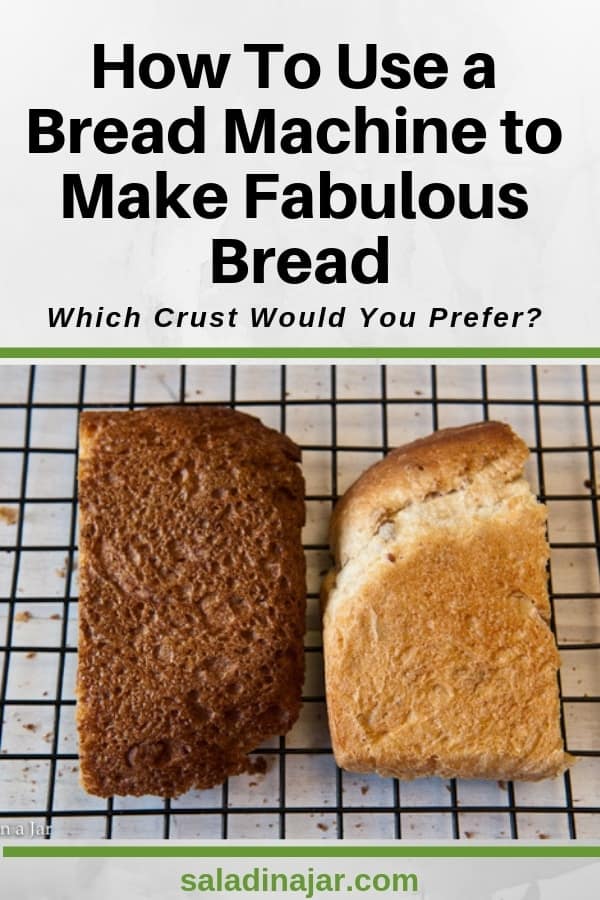
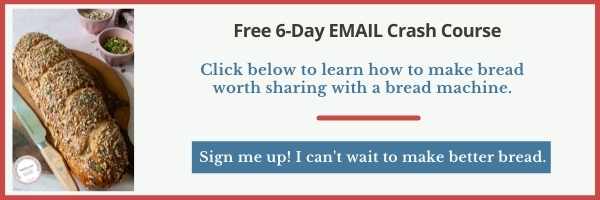

Paula Rhodes, owner
As a retired home economist, I created Saladinajar.com to share my belief that you don’t have to be a chef to find joy in creating homemade food worth sharing. Bread machines (used in an unconventional way), homemade yogurt, and quick microwave recipes are my specialty.